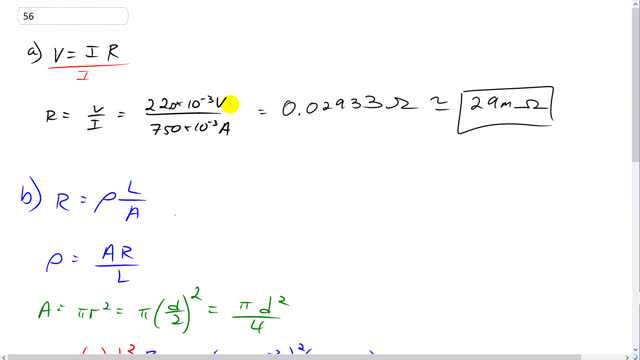
A 4.80-m length of 2.0-mm-diameter wire carries a 750-mA dc current when 22.0 mV is applied to its ends. If the drift velocity is , determine
- the resistance of the wire,
- the resistivity , and
- the number of free electrons per unit volume.

In order to watch this solution you need to have a subscription.
This is Giancoli Answers with Mr. Dychko. Voltage equals current times resistance. So, we can solve for resistance by dividing both sides by current. So, R equals V over I which is 22.0 times ten to the minus three volts divided by 750 times ten to the minus three amps which is 29 milli-ohms. And then to find the resistivity, we know resistance is resistivity times the wire length divided by its cross-sectional area and we can solve this for Rho by multiplying both sides here by A over L and so resistivity equals area times resistance divided by length. Area is pi times radius squared of the wire which is half the diameter squared and so we have pi d squared over four and so we'll substitute that in for area. Here we have pi d squared over four times R over L and that gives pi times two times ten to the minus three meter squared times 0.029333 ohms that we calculated in Part A and divide by four times length of 4.80 meters and that gives 1.9 times ten to the minus eight ohm meters is the resistivity of whatever this material is and then to find the number of free electrons per volume, we take this formula for current which is free electrons per volume times the charge on an electron times the cross sectional area of the wire times the drift velocity of electrons and we'll divide both sides by e A v d. So we have density… volume density of electrons, free electrons, is current over e A v d. So, it's 750 times ten to the minus three amps divided by 1.6 times ten to the minus 19 coulombs per electron times the area of pi times 2.0 times ten to the minus three meters squared over four. That's a diameter squared over four and then times by 1.7 times ten to the minus five meters per second drift velocity which gives 8.8 times ten to the 28 electrons per cubic meter.